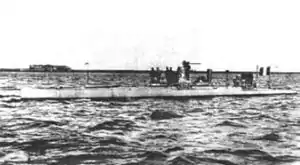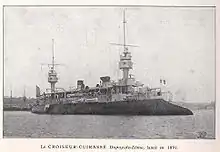Jeune École
The Jeune École ("Young School") was a strategic naval concept developed during the 19th century. It advocated the use of small, heavily armed vessels to combat larger battleships, and the use of commerce raiders to cripple the trade of the rival nation. The idea was developed among French naval theorists: the French government had the second largest navy of the time, and the theorists desired to counteract the strength of the larger British Royal Navy.
Small units against battleships
One of the first proponents of the Jeune École was the artillery general Henri-Joseph Paixhans, who invented explosive shell guns for warships during the 1820s. He advocated the use of these powerful guns on numerous small steam warships that could destroy much larger battleships.

Later, the French Navy developed the concept more elaborately as it experimented with torpedoes and torpedo boats. The French Navy became one of the strongest proponents of this combat system by the end of the 19th century.[1] The naval successes of the French Navy against China during the Sino-French War of 1883–85 also tended to validate the potential of torpedo boats against conventional navies.[2]
France was also very active in the development of a submarine fleet, again trying to rely on technical development to compensate for British numerical superiority of battleships. By the beginning of the 20th century, France was "undoubtedly the first navy to have an effective submarine force".[3] Counter measures against the Jeune École system consisted largely of destroyers, designed to deter and destroy small torpedo units (in French, "destroyer" is contre-torpilleur, and in English, "destroyer" is a contraction of "torpedo boat destroyer"), the first of which was the Destructor.
Commerce raiders

The other constitutive part of the Jeune École concept consisted of planning to raid the commercial ships of the enemy so as to curtail its trade and economy, again a tactic designed especially against Great Britain.
Raiding ships, such as the Dupuy de Lôme were designed for this role. Dupuy de Lôme, an armored cruiser, laid down during 1888, was capable of 23 knots, and designed to raid enemy commerce ships during extended forays afloat.
Influences
The Jeune École system was particularly influential on the development of smaller navies, including the Imperial Japanese Navy during the 19th century, which tried to compensate for weaknesses in battleships.
British admiral John "Jackie" Fisher, who would later become the First Sea Lord in 1904, was especially impressed by the ideas of Jeune École and felt that the threats of fast raiders and swarms of torpedo boats made the traditional battleship too unwieldy. He argued that the future lay with fast ships with light armor and big guns, which would become known as the battlecruiser, and actively promoted both its development and large scale deployment in the first decade of the 20th century.
References
- Howe, Christopher (1996). The Origins of Japanese Trade Supremacy: Development and Technology in Asia from 1540 to the Pacific War. The University of Chicago Press. ISBN 0-226-35485-7.
- Roksund, Arne. The Jeune École: The Strategy of the Weak. Leiden: Brill, 2007. ISBN 978-90-04-15273-1.
- Gardiner, Robert, and Lambert, Andrew (eds.). Steam, Steel and Shellfire: The Steam Warship 1815–1905. Conway's History of the Ship. ISBN 0-7858-1413-2.
- Ropp, Theodore. The Development of a Modern Navy: French Naval Policy 1871–1904. Ed.: Stephen S. Roberts. Annapolis, Md.: Naval Institute Press, 1987 (Harvard University dissertation from 1937).
- (de/fr) Bueb, Volkmar. Die "Junge Schule" der französischen Marine. Strategie und Politik 1875–1900. Harald Boldt Verlag, Boppard am Rhein, 1971. In: Militärgeschichtliches Forschungsamt (Editor): Wehrwissenschaftliche Forschungen, Department Militärgeschichtliche Studien, Volume 12. ISBN 3-7646-1552-4. (In German with quotations in French. Title translated to the English language: The "Jeune École" in the French Navy. Strategy and Policy 1875–1900. Book out of print. Only in scientific libraries.
Notes
- Howe, Christopher (1996). The Origins of Japanese Trade Supremacy: Development and Technology in Asia from 1540 to the Pacific War. C. Hurst & Co. p. 281. ISBN 9781850655381.
- Bueb, Volkmar (1971). Die "Junge Schule" der französischen Marine: Strategie und Politik 1875-1900. H. Boldt. p. 16. ISBN 9783764615529.
- Gardiner, Robert (1992). Steam, Steel & Shellfire: The Steam Warship 1815-1905. Conway Maritime Press. p. 154. ISBN 9780851775647.
Literary appearances
- Weber, David (1993). On Basilisk Station. [1]
External links
- Net-Centric before its time: The Jeune École and Its Lessons for Today Erik J. Dahl US Naval War College Review, Autumn 2005, Vol. 58, No. 4
- (fr) François-Emmanuel Brézet: Enseignements de l'histoire et progrès technique: L'example de l'élaboration de la doctrine de la Jeune École française (title translated to english: Lessons from history and technical progress: Example how the ideas of the french Jeune École were elaborated)